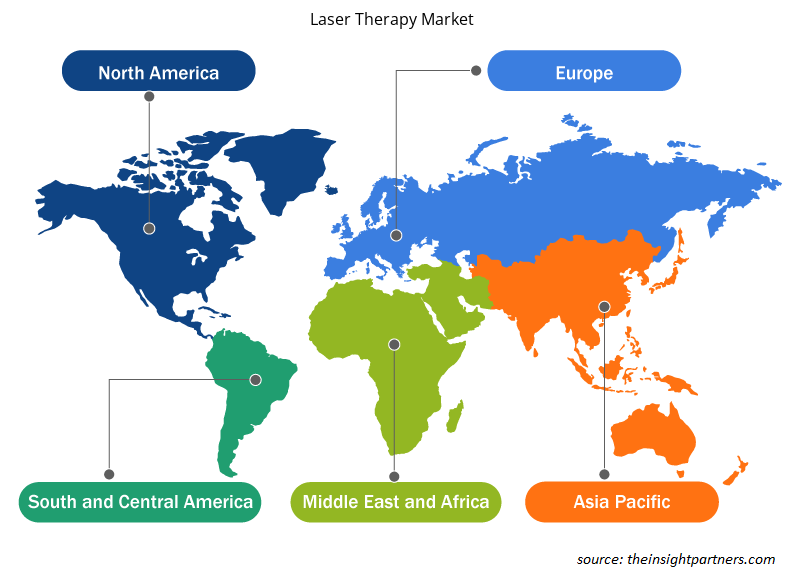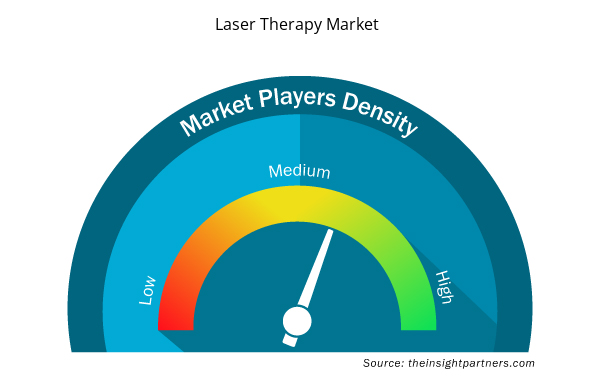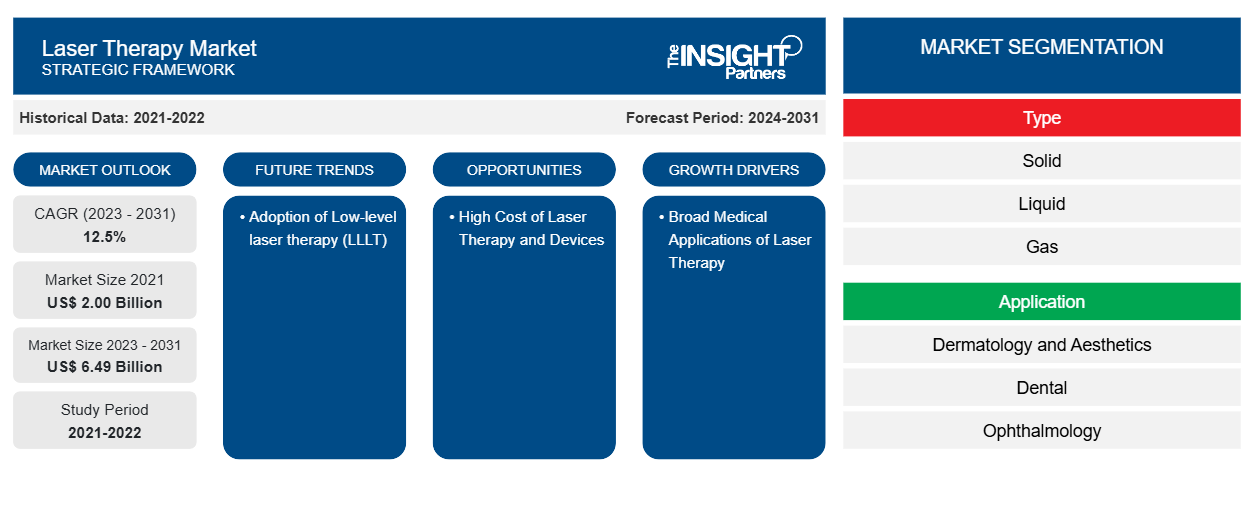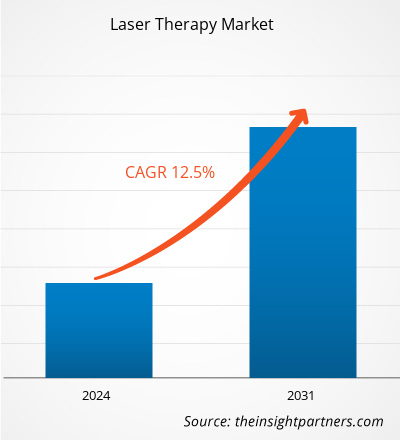Der Markt für Lasertherapien belief sich 2021 auf 2,00 Milliarden US-Dollar und soll von XX Milliarden US-Dollar im Jahr 2023 auf 6,49 Milliarden US-Dollar im Jahr 2031 anwachsen. Der Markt wird voraussichtlich zwischen 2023 und 2031 eine durchschnittliche jährliche Wachstumsrate (CAGR) von 12,5 % verzeichnen. Das wachsende Bewusstsein für die Lasertherapie mit ihren geringeren Gesundheitsrisiken und die Akzeptanz in Entwicklungsregionen werden wahrscheinlich weiterhin die wichtigsten Trends auf dem Markt für Lasertherapien bleiben.
Marktanalyse für Lasertherapie
Die zunehmende Vorliebe der Verbraucher für innovative und nichtinvasive laserbasierte Technologien wird die weltweite Nachfrage nach Lasertherapien ankurbeln. Eine wachsende geriatrische Bevölkerung wird die Nachfrage nach dieser Technologie erhöhen, da sie Schmerzen und Entzündungen lindert. Die zunehmende Zahl von Augenkrankheiten wird das Wachstum des Lasertherapiemarktes ebenfalls fördern. Der Anstieg des verfügbaren Einkommens und der Nachfrage nach Schönheitsoperationen dürften darüber hinaus lukrativere Möglichkeiten für Marktwachstum schaffen. Die Einführung von Lasertherapiegeräten durch Ärzte und medizinisches Fachpersonal zur Behandlung von Narben und Wunden sowie ihre vielfältigen Anwendungen, wie z. B. Gewebekoagulation und Entfernung bösartiger Tumore, erhöhen die Nachfrage nach diesen fortschrittlichen medizinischen Technologien. Die hohen Kosten für die Installation und Wartung der Technologie werden das Marktwachstum jedoch bremsen. Darüber hinaus werden strenge staatliche Vorschriften für den Erwerb und die Installation der Technologie das Marktwachstum bremsen.
Marktübersicht zur Lasertherapie
Die Lasertherapie nutzt den Mechanismus der Photobiomodulation, bei dem die Photonen das Gewebe durchdringen und mit ihm interagieren. Diese Interaktion erhöht den Zellstoffwechsel und hilft, Schmerzen und Entzündungen zu lindern. Minimalinvasive chirurgische Eingriffe sind im weltweiten Gesundheitswesen in den Mittelpunkt gerückt. Das Auftreten von Operationswunden und damit verbundenen Infektionen bei herkömmlichen Verfahren hat eine Umstellung auf alternative Ansätze erforderlich gemacht. Es besteht ein wachsender Bedarf an tragbaren und handgeführten Lasergeräten für die Behandlung zu Hause und ambulant. Eine deutliche Ausweitung der Anwendungen über die traditionelle Dermatologie hinaus mit Lasertherapiegeräten in der Zahnmedizin, Augenheilkunde und Onkologie wird voraussichtlich die Marktaussichten prägen. Die hohe Ausfallrate laserbasierter chirurgischer Eingriffe und die Nebenwirkungen der Lasertherapie werden das Marktwachstum weiter behindern.
Passen Sie diesen Bericht Ihren Anforderungen an
Sie erhalten kostenlos individuelle Anpassungen an jedem Bericht, einschließlich Teilen dieses Berichts oder einer Analyse auf Länderebene, eines Excel-Datenpakets sowie tolle Angebote und Rabatte für Start-ups und Universitäten.
- Holen Sie sich die wichtigsten Markttrends aus diesem Bericht.Dieses KOSTENLOSE Beispiel umfasst eine Datenanalyse von Markttrends bis hin zu Schätzungen und Prognosen.
Treiber und Chancen auf dem Markt für Lasertherapie
Wachsende Produktneueinführungen begünstigen den Markt
Die Verfügbarkeit verschiedener fortschrittlicher Produkte auf dem Markt ermöglicht es Medizinern, die Gesundheit der Patienten zu verbessern, indem sie deren Behandlungseffizienz steigern. So brachte beispielsweise IRIDEX Corporation, ein Hersteller laserbasierter Medizinprodukte für die Augenheilkunde, im Februar 2020 eine verbesserte Version der zweiten Generation des MicroPulse P3-Geräts zur Behandlung von Glaukom auf den Markt. Die Verbesserungen des Geräts sollen den Augeninnendruck erheblich senken und Glaukompatienten ohne Einschnitte helfen. Im Oktober 2023 stellte Abbott in Indien seine Gefäßbildgebungsplattform mit der Software Ultreon 1.0 vor, die optische Kohärenztomographie (OCT) mit KI kombiniert, um Ärzten einen umfassenden Überblick über den Blutfluss und Blockaden in den Herzkranzgefäßen zu geben. Im Januar 2022 erhielt das laserunterstützte Spülgerät EdgePRO, das als wirksame Reinigungs- und Desinfektionsalternative bei Wurzelkanalbehandlungen eingesetzt wurde, die FDA 510(k)-Zulassung von BILOASE, Inc., einem bedeutenden Anbieter von Dentallasern, und EdgeEndo, einem Unternehmen zur Vermarktung endodontischer Produkte.
Entwicklungen in der Lasertechnologie – eine Chance für das Wachstum des Lasertherapiemarktes
Kontinuierliche Fortschritte in der Lasertechnologie, einschließlich der Entwicklung präziserer und zielgerichteterer Lasersysteme, haben die Anwendungsmöglichkeiten der Lasertherapie in verschiedenen medizinischen Bereichen erweitert. Das Aufkommen tragbarer und handgehaltener Lasergeräte hat die Ausweitung der Lasertherapie über den klinischen Bereich hinaus erleichtert und ermöglicht Patienten die Behandlung bequem von zu Hause aus. Dieser Zugänglichkeits- und Komfortfaktor hat maßgeblich zur Marktdurchdringung beigetragen. Die Lasertherapie wird in der Krebsbehandlung zur Tumorablation, zur photodynamischen Therapie (PDT) und zur laserinduzierten interstitiellen Thermotherapie eingesetzt. Gezielte, durch bildgebende Verfahren gesteuerte Lasertherapien verbessern die Präzision der Krebsbehandlung . Entwicklungen bei photothermischen und photochemischen Therapien tragen zu wirksameren und lokalisierten Krebseingriffen bei. Fortschritte bei Laserparametern wie Wellenlänge und Leistungsdichte tragen zu optimierten Photobiomodulationsergebnissen bei. Die Low-Level-Light-Therapie (LLLT) ist eine nicht-invasive Technik zur Förderung der Geweberegeneration und -reparatur.
Interessanterweise hat diese Therapie eine herausragende Wirksamkeit bei Haarwachstum und Hautverjüngung gezeigt. Laserinduzierte regenerative Therapien sind vielversprechend für die Förderung der Heilung in verschiedenen medizinischen Bereichen. Diese technologischen Innovationen haben zu besseren Behandlungsergebnissen geführt und bieten lukrative Möglichkeiten für Marktwachstum.
Segmentierungsanalyse des Marktberichts zur Lasertherapie
Wichtige Segmente, die zur Ableitung der Marktanalyse für Lasertherapie beigetragen haben, sind Typ, Anwendung und Endbenutzer.
- Der Markt für Lasertherapien ist nach Typ in Feststoffe, Flüssigkeiten, Gase und Dioden unterteilt. Im Jahr 2023 hatte das Segment der Aneurysma-Coiling- und Embolisationsgeräte den größten Marktanteil, und es wird erwartet, dass dasselbe Segment im Prognosezeitraum die höchste durchschnittliche jährliche Wachstumsrate verzeichnet. Das Segment ist weiter unterteilt in Embolie-Coils, blanke abnehmbare Coils, beschichtete abnehmbare Coils, Durchflussumleitungsgeräte und flüssige Emboliemittel.
- Nach Anwendung ist der Markt in Dermatologie und Ästhetik, Zahnmedizin, Augenheilkunde, Urologie, Herz-Kreislauf, Onkologie und andere unterteilt. Im Jahr 2023 hatte das Segment ischämische Schlaganfälle den größten Marktanteil, und es wird erwartet, dass dasselbe Segment zwischen 2023 und 2031 die höchste durchschnittliche jährliche Wachstumsrate verzeichnet.
- In Bezug auf den Endverbraucher ist der Markt in Fachkliniken, Krankenhäuser, Ambulanzen und andere unterteilt. Im Jahr 2023 hielt das Krankenhaussegment den größten Marktanteil, und es wird geschätzt, dass dasselbe Segment im Prognosezeitraum die höchste durchschnittliche jährliche Wachstumsrate verzeichnet. Das Krankenhaussegment wird im kommenden Jahr voraussichtlich am schnellsten wachsen, da bessere Gesundheitseinrichtungen verfügbar sind und die Erstattungsrichtlinien der Regierungsbehörden gelten.
Marktanteilsanalyse für Lasertherapie nach geografischer Lage
Der geografische Umfang des Marktberichts zur Lasertherapie ist hauptsächlich in fünf Regionen unterteilt: Nordamerika, Asien-Pazifik, Europa, Naher Osten und Afrika sowie Südamerika/Süd- und Mittelamerika.
Nordamerika dominiert den Markt für Lasertherapie. Der Markt für Lasertherapiegeräte in Nordamerika dürfte aufgrund neuer Produktentwicklungen in der Region deutlich wachsen. Steigende Gesundheitsausgaben und öffentliches Bewusstsein tragen ebenfalls zum Marktwachstum in dieser Region bei. Die Weiterentwicklung von Lasertherapiegeräten in verschiedenen Anwendungsbereichen wie Neurochirurgie, Gynäkologie oder Augenheilkunde, zunehmende staatliche Zulassungen und die Präsenz wichtiger Marktteilnehmer in der Region führen zum Wachstum des Marktes für Lasertherapie. Darüber hinaus sind zunehmende Produkteinführungen für das Marktwachstum verantwortlich. In dieser Region gibt es viele wichtige Entwicklungen, technologische Fortschritte, Kooperationen und Vereinbarungen. So kündigte beispielsweise Solta Medical, ein Teil von Bausch Health Companies Inc., einem Anbieter medizinischer Ästhetik, am 8. März 2021 die Markteinführung seines Clear + Brilliant Touch-Lasers der nächsten Generation in den USA an. Der Clear + Brilliant Touch-Laser bietet ein umfassendes und personalisiertes Behandlungsprotokoll, indem er Patienten aller Hauttypen und Altersgruppen die Vorteile doppelter Wellenlängen bietet. Der asiatisch-pazifische Raum dürfte in den kommenden Jahren mit der höchsten durchschnittlichen jährlichen Wachstumsrate wachsen.
Regionale Einblicke in den Markt für Lasertherapie
Die regionalen Trends und Faktoren, die den Markt für Lasertherapie im Prognosezeitraum beeinflussen, wurden von den Analysten von Insight Partners ausführlich erläutert. In diesem Abschnitt werden auch die Marktsegmente und die Geografie der Lasertherapie in Nordamerika, Europa, im asiatisch-pazifischen Raum, im Nahen Osten und Afrika sowie in Süd- und Mittelamerika erörtert.

- Erhalten Sie regionale Daten zum Lasertherapiemarkt
Umfang des Marktberichts zur Lasertherapie
| Berichtsattribut | Details |
|---|---|
| Marktgröße im Jahr 2021 | 2,00 Milliarden US-Dollar |
| Marktgröße bis 2031 | 6,49 Milliarden US-Dollar |
| Globale CAGR (2023 - 2031) | 12,5 % |
| Historische Daten | 2021-2022 |
| Prognosezeitraum | 2024–2031 |
| Abgedeckte Segmente | Nach Typ
|
| Abgedeckte Regionen und Länder | Nordamerika
|
| Marktführer und wichtige Unternehmensprofile |
|
Dichte der Marktteilnehmer für Lasertherapie: Auswirkungen auf die Geschäftsdynamik verstehen
Der Markt für Lasertherapie wächst rasant, angetrieben durch die steigende Nachfrage der Endnutzer aufgrund von Faktoren wie sich entwickelnden Verbraucherpräferenzen, technologischen Fortschritten und einem größeren Bewusstsein für die Vorteile des Produkts. Mit steigender Nachfrage erweitern Unternehmen ihr Angebot, entwickeln Innovationen, um die Bedürfnisse der Verbraucher zu erfüllen, und nutzen neue Trends, was das Marktwachstum weiter ankurbelt.
Die Marktteilnehmerdichte bezieht sich auf die Verteilung der Firmen oder Unternehmen, die in einem bestimmten Markt oder einer bestimmten Branche tätig sind. Sie gibt an, wie viele Wettbewerber (Marktteilnehmer) in einem bestimmten Marktraum im Verhältnis zu seiner Größe oder seinem gesamten Marktwert präsent sind.
Die wichtigsten auf dem Markt für Lasertherapie tätigen Unternehmen sind:
- Alma Lasers,
- Coherent, Inc.,
- biolitec-Gruppe,
- BIOLASE, Inc.,
- IPG Photonics Corporation,
- Boston Scientific Corporation,
Haftungsausschluss : Die oben aufgeführten Unternehmen sind nicht in einer bestimmten Reihenfolge aufgeführt.

- Überblick über die wichtigsten Akteure auf dem Markt für Lasertherapie
Neuigkeiten und aktuelle Entwicklungen zum Lasertherapiemarkt
Der Markt für Lasertherapie wird durch die Erhebung qualitativer und quantitativer Daten aus Primär- und Sekundärforschung bewertet, die wichtige Unternehmenspublikationen, Verbandsdaten und Datenbanken einschließen. Nachfolgend finden Sie eine Liste der Entwicklungen auf dem Markt für Lasertherapie:
- Theralase Technologies Inc., ein Pharmaunternehmen im klinischen Stadium, das sich der Forschung und Entwicklung von licht- und/oder strahlungsaktivierten Photodynamischen Verbindungen („PDCs“) zur sicheren und wirksamen Zerstörung verschiedener Krebsarten, Bakterien und Viren widmet, spendete der University of Windsor zwei Theralase TLC-2400 Cool Laser Therapy („CLT“)-Systeme, um die Forschung und Entwicklung einer neuartigen Behandlung für Patienten mit Parkinson-Krankheit („Parkinson“) zu unterstützen. (Theralase Technologies Inc., Pressemitteilung, 2024)
- ViaLase hat sich im Rahmen der Serie-C-Finanzierung rund 40 Millionen US-Dollar gesichert, um die weitere Entwicklung des Femtosekundenlasers des Unternehmens zur Behandlung von Glaukom voranzutreiben. Die Finanzierung wurde von einem neuen Investor geleitet und von bestehenden Investoren unterstützt, darunter Venture Investors Health Fund, Arboretum Ventures und Falcon Vision. (ViaLase, Inc., News, 2024)
- Norlase, weltweit führender Hersteller von ophthalmischen Lasern, der Laserlösungen der nächsten Generation entwickelt, gab bekannt, dass er seine bisher größte Investitionsrunde abgeschlossen hat. Die Finanzierung in Höhe von 11 Millionen US-Dollar wurde von der in London ansässigen Firma West Hill Capital geleitet. Die Finanzierung erfolgte unmittelbar nach der FDA-Zulassung und der CE-Kennzeichnung des bislang fortschrittlichsten Produkts des Unternehmens, des ECHO-Musterlasers. Dadurch konnte Norlase den Produktionsanlauf des ECHO-Musterlasers sowie seiner anderen hochmodernen Laserbehandlungslösungen beschleunigen. (Norlase, News, 2023)
- ViaLase, Inc., ein Medizintechnikunternehmen im klinischen Stadium, das sich auf die Erfüllung unerfüllter Bedürfnisse im konventionellen Glaukombehandlungsparadigma konzentriert, gab die Aufnahme von VIA-002 bekannt, der zentralen Studie des Unternehmens zum ViaLase-Laser zur Behandlung erwachsener Patienten mit primärem Offenwinkelglaukom (POAG). Der ViaLase-Laser kombiniert die Präzision der Femtosekundenlasertechnologie und die Genauigkeit der Bildführung im Mikronbereich, um eine nicht-invasive Glaukombehandlung namens femtosekundenlaser-bildgeführte hochpräzise Trabekulotomie oder FLigHT durchzuführen. (ViaLase, Inc., News, 2023)
Marktbericht zur Lasertherapie – Umfang und Ergebnisse
Der Bericht „Marktgröße und Prognose für Lasertherapie (2021–2031)“ bietet eine detaillierte Analyse des Marktes, die die folgenden Bereiche abdeckt:
- Marktgröße und Prognose auf globaler, regionaler und Länderebene für alle wichtigen Marktsegmente, die im Rahmen des Projekts abgedeckt sind
- Marktdynamik wie Treiber, Beschränkungen und wichtige Chancen
- Wichtige Zukunftstrends
- Detaillierte PEST/Porters Five Forces- und SWOT-Analyse
- Globale und regionale Marktanalyse mit wichtigen Markttrends, wichtigen Akteuren, Vorschriften und aktuellen Marktentwicklungen
- Branchenlandschaft und Wettbewerbsanalyse, einschließlich Marktkonzentration, Heatmap-Analyse, prominenten Akteuren und aktuellen Entwicklungen
- Detaillierte Firmenprofile
- Historische Analyse (2 Jahre), Basisjahr, Prognose (7 Jahre) mit CAGR
- PEST- und SWOT-Analyse
- Marktgröße Wert/Volumen – Global, Regional, Land
- Branche und Wettbewerbsumfeld
- Excel-Datensatz


- Fish Protein Hydrolysate Market
- Cling Films Market
- Electronic Signature Software Market
- Embolization Devices Market
- Pipe Relining Market
- Human Microbiome Market
- Single-Use Negative Pressure Wound Therapy Devices Market
- Smart Water Metering Market
- Social Employee Recognition System Market
- Rugged Servers Market

Report Coverage
Revenue forecast, Company Analysis, Industry landscape, Growth factors, and Trends

Segment Covered
This text is related
to segments covered.

Regional Scope
North America, Europe, Asia Pacific, Middle East & Africa, South & Central America

Country Scope
This text is related
to country scope.
Trends and growth analysis reports related to Life Sciences : READ MORE..
The Insight Partners performs research in 4 major stages: Data Collection & Secondary Research, Primary Research, Data Analysis and Data Triangulation & Final Review.
- Data Collection and Secondary Research:
As a market research and consulting firm operating from a decade, we have published and advised several client across the globe. First step for any study will start with an assessment of currently available data and insights from existing reports. Further, historical and current market information is collected from Investor Presentations, Annual Reports, SEC Filings, etc., and other information related to company’s performance and market positioning are gathered from Paid Databases (Factiva, Hoovers, and Reuters) and various other publications available in public domain.
Several associations trade associates, technical forums, institutes, societies and organization are accessed to gain technical as well as market related insights through their publications such as research papers, blogs and press releases related to the studies are referred to get cues about the market. Further, white papers, journals, magazines, and other news articles published in last 3 years are scrutinized and analyzed to understand the current market trends.
- Primary Research:
The primarily interview analysis comprise of data obtained from industry participants interview and answers to survey questions gathered by in-house primary team.
For primary research, interviews are conducted with industry experts/CEOs/Marketing Managers/VPs/Subject Matter Experts from both demand and supply side to get a 360-degree view of the market. The primary team conducts several interviews based on the complexity of the markets to understand the various market trends and dynamics which makes research more credible and precise.
A typical research interview fulfils the following functions:
- Provides first-hand information on the market size, market trends, growth trends, competitive landscape, and outlook
- Validates and strengthens in-house secondary research findings
- Develops the analysis team’s expertise and market understanding
Primary research involves email interactions and telephone interviews for each market, category, segment, and sub-segment across geographies. The participants who typically take part in such a process include, but are not limited to:
- Industry participants: VPs, business development managers, market intelligence managers and national sales managers
- Outside experts: Valuation experts, research analysts and key opinion leaders specializing in the electronics and semiconductor industry.
Below is the breakup of our primary respondents by company, designation, and region:

Once we receive the confirmation from primary research sources or primary respondents, we finalize the base year market estimation and forecast the data as per the macroeconomic and microeconomic factors assessed during data collection.
- Data Analysis:
Once data is validated through both secondary as well as primary respondents, we finalize the market estimations by hypothesis formulation and factor analysis at regional and country level.
- Macro-Economic Factor Analysis:
We analyse macroeconomic indicators such the gross domestic product (GDP), increase in the demand for goods and services across industries, technological advancement, regional economic growth, governmental policies, the influence of COVID-19, PEST analysis, and other aspects. This analysis aids in setting benchmarks for various nations/regions and approximating market splits. Additionally, the general trend of the aforementioned components aid in determining the market's development possibilities.
- Country Level Data:
Various factors that are especially aligned to the country are taken into account to determine the market size for a certain area and country, including the presence of vendors, such as headquarters and offices, the country's GDP, demand patterns, and industry growth. To comprehend the market dynamics for the nation, a number of growth variables, inhibitors, application areas, and current market trends are researched. The aforementioned elements aid in determining the country's overall market's growth potential.
- Company Profile:
The “Table of Contents” is formulated by listing and analyzing more than 25 - 30 companies operating in the market ecosystem across geographies. However, we profile only 10 companies as a standard practice in our syndicate reports. These 10 companies comprise leading, emerging, and regional players. Nonetheless, our analysis is not restricted to the 10 listed companies, we also analyze other companies present in the market to develop a holistic view and understand the prevailing trends. The “Company Profiles” section in the report covers key facts, business description, products & services, financial information, SWOT analysis, and key developments. The financial information presented is extracted from the annual reports and official documents of the publicly listed companies. Upon collecting the information for the sections of respective companies, we verify them via various primary sources and then compile the data in respective company profiles. The company level information helps us in deriving the base number as well as in forecasting the market size.
- Developing Base Number:
Aggregation of sales statistics (2020-2022) and macro-economic factor, and other secondary and primary research insights are utilized to arrive at base number and related market shares for 2022. The data gaps are identified in this step and relevant market data is analyzed, collected from paid primary interviews or databases. On finalizing the base year market size, forecasts are developed on the basis of macro-economic, industry and market growth factors and company level analysis.
- Data Triangulation and Final Review:
The market findings and base year market size calculations are validated from supply as well as demand side. Demand side validations are based on macro-economic factor analysis and benchmarks for respective regions and countries. In case of supply side validations, revenues of major companies are estimated (in case not available) based on industry benchmark, approximate number of employees, product portfolio, and primary interviews revenues are gathered. Further revenue from target product/service segment is assessed to avoid overshooting of market statistics. In case of heavy deviations between supply and demand side values, all thes steps are repeated to achieve synchronization.
We follow an iterative model, wherein we share our research findings with Subject Matter Experts (SME’s) and Key Opinion Leaders (KOLs) until consensus view of the market is not formulated – this model negates any drastic deviation in the opinions of experts. Only validated and universally acceptable research findings are quoted in our reports.
We have important check points that we use to validate our research findings – which we call – data triangulation, where we validate the information, we generate from secondary sources with primary interviews and then we re-validate with our internal data bases and Subject matter experts. This comprehensive model enables us to deliver high quality, reliable data in shortest possible time.


 Holen Sie sich ein kostenloses Muster für diesen Bericht
Holen Sie sich ein kostenloses Muster für diesen Bericht